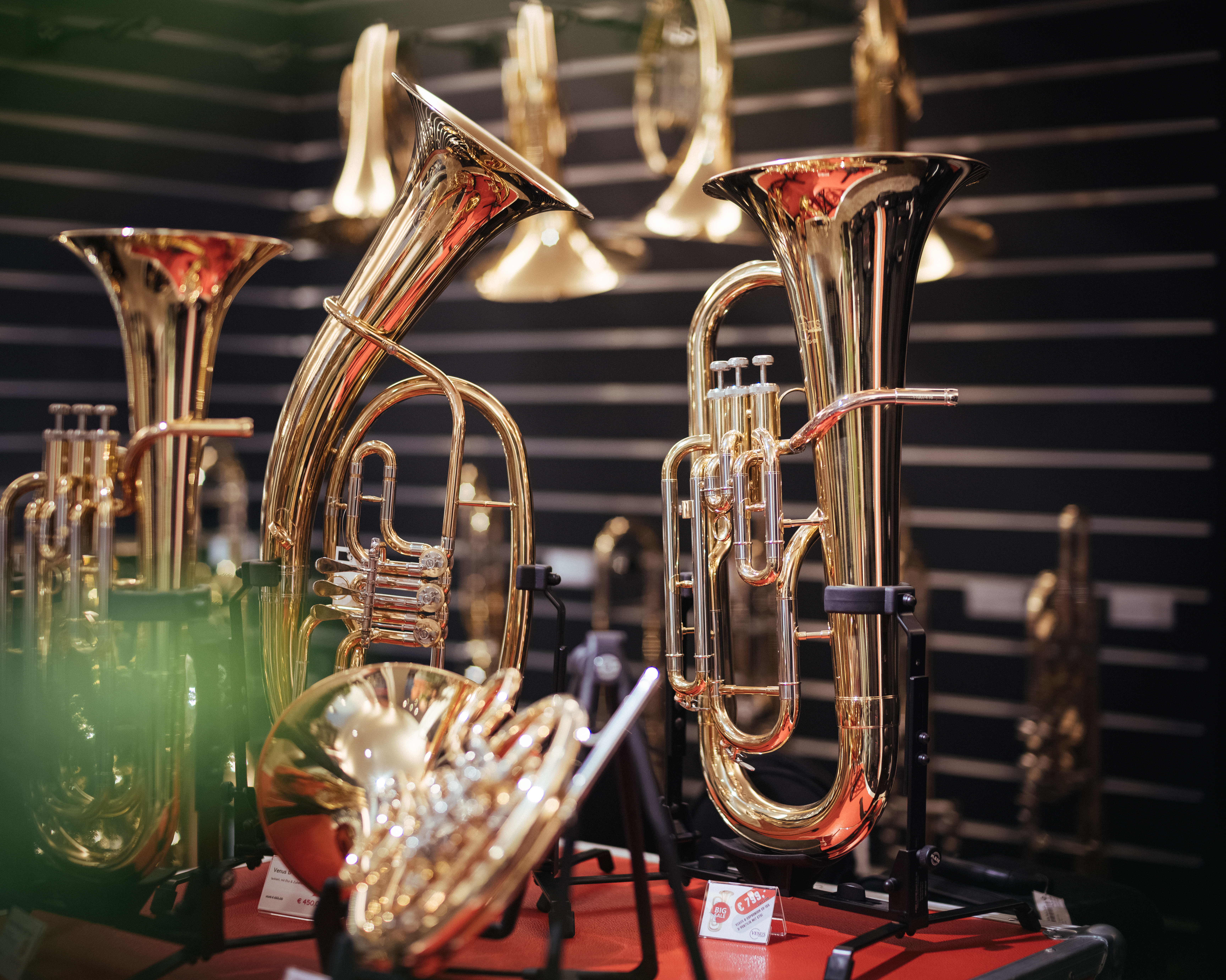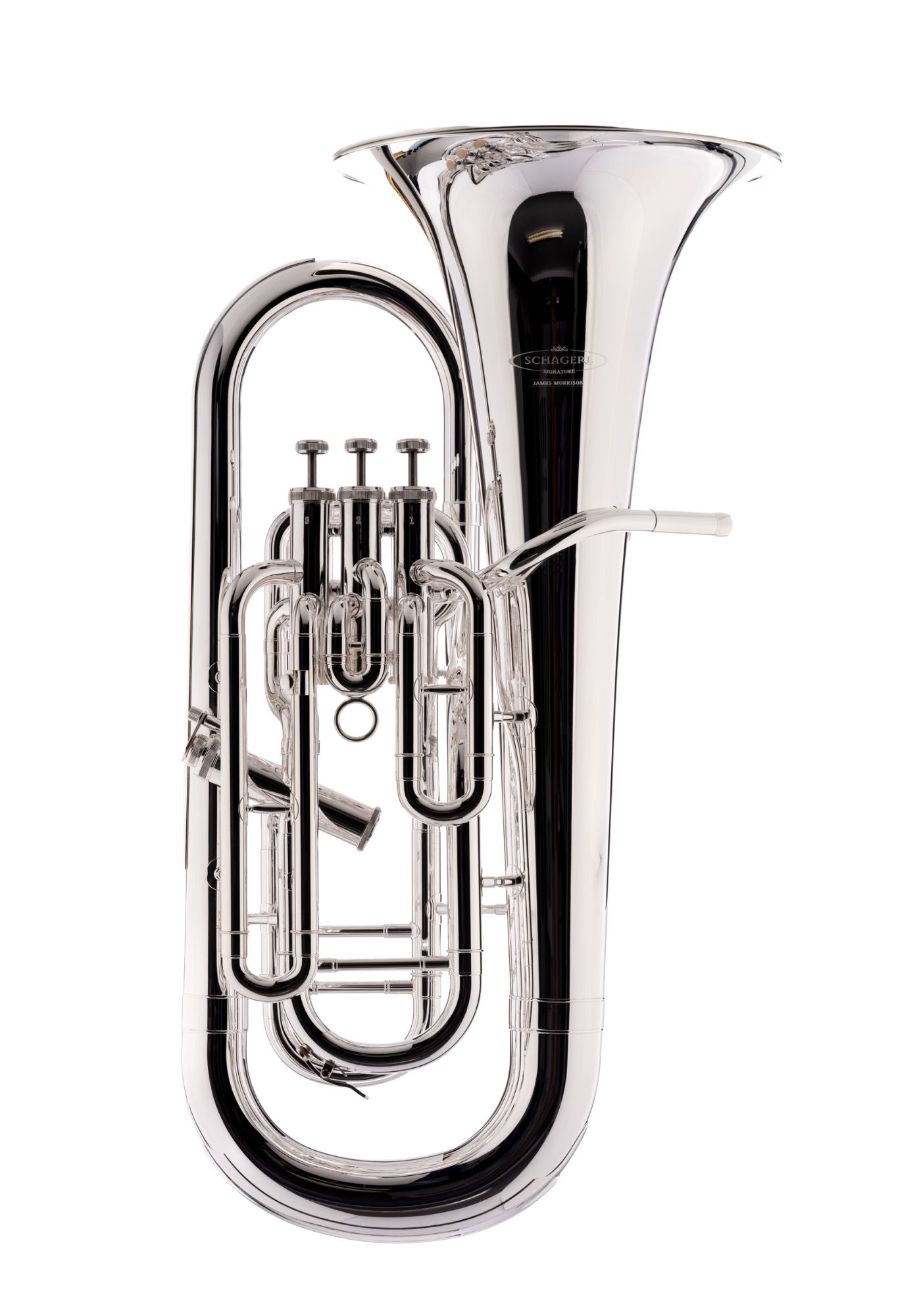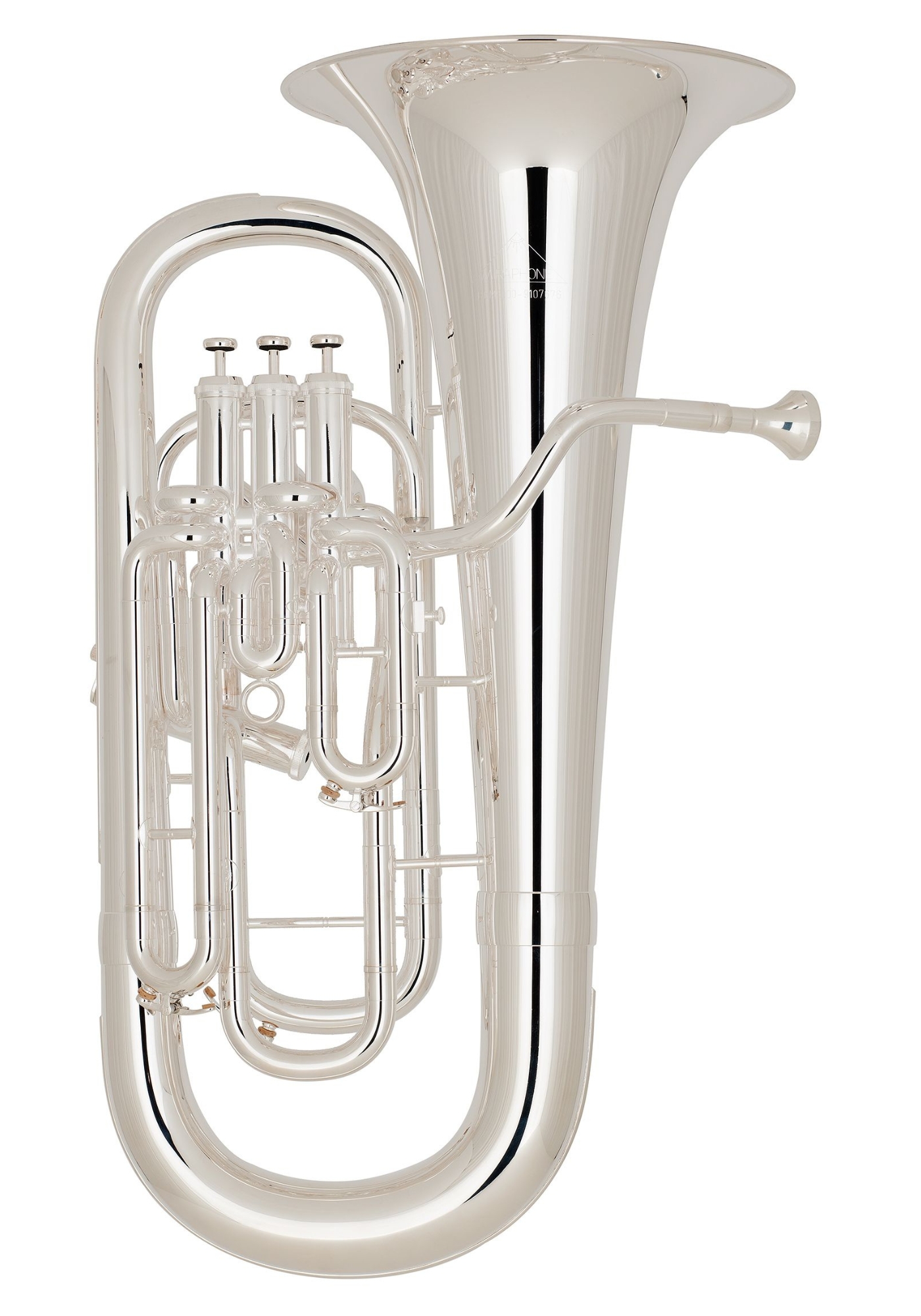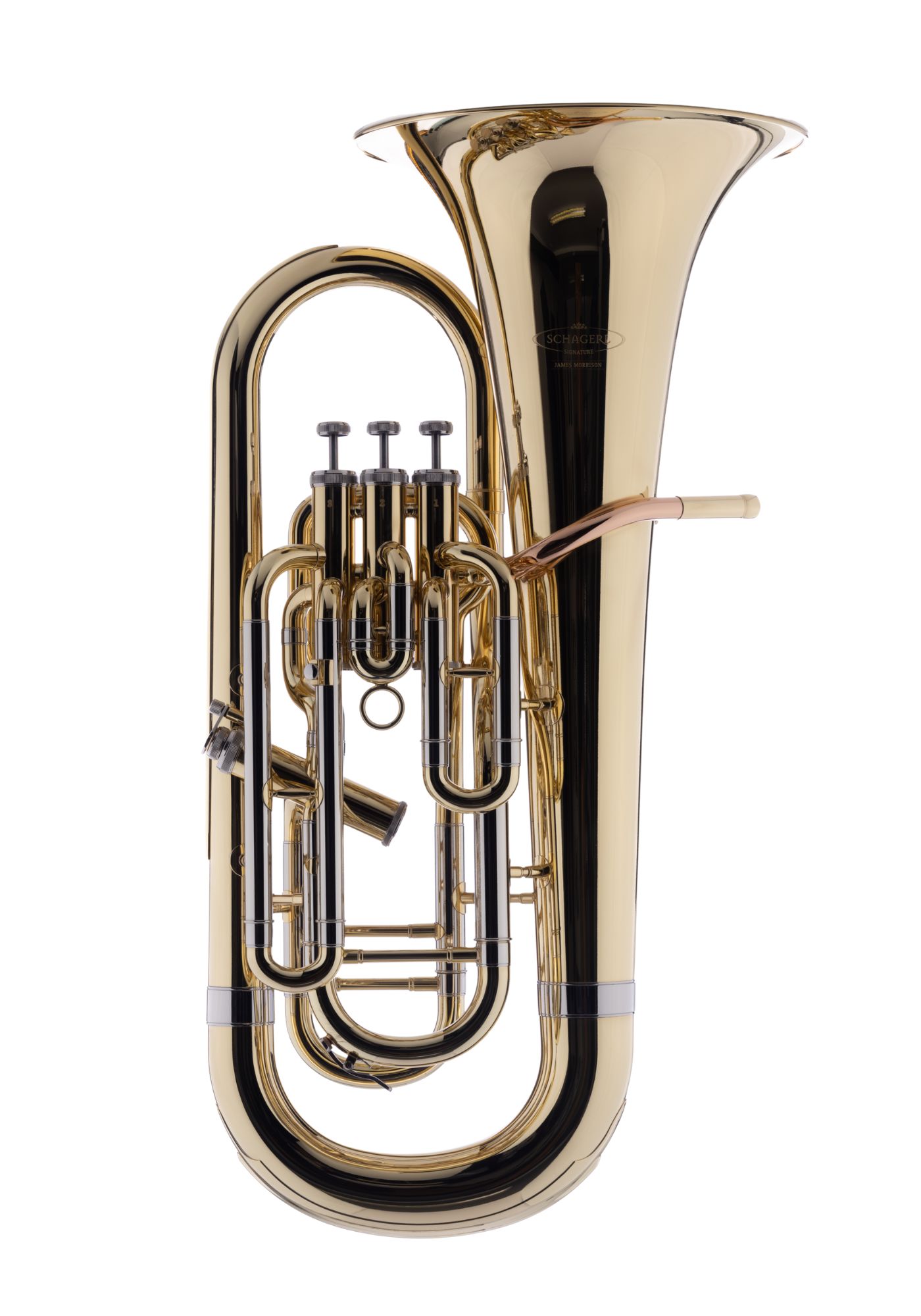
Euphonium
Euphonium - The gentle sound giant among the brass instruments
The euphonium, a versatile brass instrument in the tenor register, is characterised by its warm, full sound and impressive dynamics. Often referred to as the ‘cello of wind instruments’, the euphonium has a soft and harmonious sound that is appreciated both in wind orchestras and brass bands. With its low pitch, full tone colour and ability to play melodic and rhythmic passages with equal expression, the euphonium offers unique tonal depth and flexibility.
The special features of the euphonium
The euphonium belongs to the brass family and is closely related to the baritone, but differs in its wider bore (tube diameter) and the resulting rounder, fuller sound. The instrument is usually tuned in Bb and has three or four valves, depending on the model, which enable a wide range of tones and tonal nuances. Players appreciate the euphonium for its ability to produce both soft, lyrical melodies and powerful, bass-emphasised accompaniments.
The history of the euphonium
The euphonium originated in the mid-19th century as a further development of other low-sounding brass instruments such as the serpent and the ophicleide. The German instrument maker Ferdinand Sommer developed the first euphonium around 1843, which quickly gained popularity and found a permanent place in military and brass music. In the following decades, the euphonium was continuously improved and its construction further refined, so that it was also recognised in symphony orchestras and as a solo instrument. In England in particular, the euphonium became an integral part of the brass band tradition, where it still plays a central role today.
Difference between euphonium and baritone
Although the euphonium and the baritone are often confused with each other, there are some significant differences between the two instruments. The euphonium has a wider bore and therefore produces a softer, fuller sound, while the baritone has a slightly brighter tone. In addition, the euphonium is often somewhat more voluminous due to its deeper construction and is particularly suitable for melodic passages and solo performances, while the baritone is often used for rhythmic accompaniments and as harmonic support in an ensemble.Tips for beginners:
How to get started playing the euphonium
The euphonium is ideal for beginners who are enthusiastic about brass music and are looking for a powerful-sounding instrument with a warm tone.
Here are some tips for a successful introduction to playing the euphonium:
Choose an instrument: A simple euphonium with three valves is ideal for beginners as it is easier to handle. Advanced players can choose a euphonium with four valves to cover a wider range.
Practise your breathing technique: The right breathing technique is crucial to making the euphonium sound full. Breathing exercises help to control the air flow and achieve stable sound production.
Practise regularly: Playing the euphonium requires practice, especially to master the low notes and clean intonation.
Care of the instrument: The euphonium should be cleaned regularly and the valves oiled to ensure smooth operation and clean sounds.
Find a teacher or wind band: A professional teacher can provide valuable technique tips, and participation in a wind band offers the opportunity to learn directly in an ensemble.
Here are some tips for a successful introduction to playing the euphonium:
Choose an instrument: A simple euphonium with three valves is ideal for beginners as it is easier to handle. Advanced players can choose a euphonium with four valves to cover a wider range.
Practise your breathing technique: The right breathing technique is crucial to making the euphonium sound full. Breathing exercises help to control the air flow and achieve stable sound production.
Practise regularly: Playing the euphonium requires practice, especially to master the low notes and clean intonation.
Care of the instrument: The euphonium should be cleaned regularly and the valves oiled to ensure smooth operation and clean sounds.
Find a teacher or wind band: A professional teacher can provide valuable technique tips, and participation in a wind band offers the opportunity to learn directly in an ensemble.
Frequently asked questions about the euphonium
1. Is the euphonium difficult to learn?
The euphonium is relatively beginner-friendly, but playing it requires good breathing technique and regular practice in order to achieve clean tones and stable intonation.
2. What is the difference between the euphonium and the baritone?
The euphonium has a wider bore and a softer, fuller sound, while the baritone sounds somewhat brighter and is often used for rhythmic accompaniments.
3. Which euphonium is suitable for beginners?
A simple three-valve euphonium is ideal for beginners as it is easier to handle. Advanced players can choose a four-valve euphonium to play a wider range.
4. How do you look after a euphonium?
The euphonium should be cleaned regularly, the valves should be oiled and the mouthpiece should be kept hygienically clean to avoid corrosion and deposits.
5. In which musical genres is the euphonium used?
The euphonium is particularly popular in wind orchestras, brass bands and classical music. It is also occasionally used in film music.
The euphonium is relatively beginner-friendly, but playing it requires good breathing technique and regular practice in order to achieve clean tones and stable intonation.
2. What is the difference between the euphonium and the baritone?
The euphonium has a wider bore and a softer, fuller sound, while the baritone sounds somewhat brighter and is often used for rhythmic accompaniments.
3. Which euphonium is suitable for beginners?
A simple three-valve euphonium is ideal for beginners as it is easier to handle. Advanced players can choose a four-valve euphonium to play a wider range.
4. How do you look after a euphonium?
The euphonium should be cleaned regularly, the valves should be oiled and the mouthpiece should be kept hygienically clean to avoid corrosion and deposits.
5. In which musical genres is the euphonium used?
The euphonium is particularly popular in wind orchestras, brass bands and classical music. It is also occasionally used in film music.
The euphonium is a unique instrument that impresses with its depth of sound and versatility. Whether as a solo instrument, in brass bands or wind orchestras - the euphonium brings an unmistakable warmth and richness to the music and enriches every musical composition.
Buy euphonium at Schagerl:
Large selection: Schagerl offers a wide range of products, from cornets to an extensive range of accessories. This variety means that every musician can discover the right instrument for their style and requirements.Expert advice: Schagerl employs experienced musicians and specially trained staff who offer professional and personalised advice. Whether beginner or professional, every customer receives the support they need to find the perfect instrument.
Best customer service: Customer service at Schagerl stands for reliability and commitment. In addition to personalised advice, customers also benefit from services such as repairs, maintenance and the purchase of accessories, which makes the entire purchasing process uncomplicated and pleasant.




